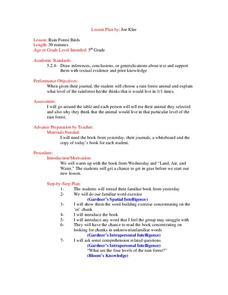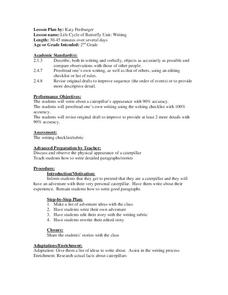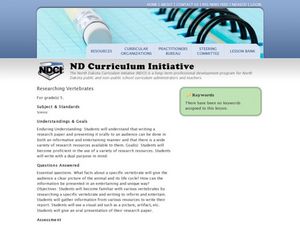Curated OER
P & P "Portraits and Perspective" Digital Photography for Kids
Students use digital photography as a lesson on portraits and perspective. For this photography lesson, students explore their school grounds and take pictures using their cameras. Students' goal is to create architectural and...
Curated OER
How Does One Cope With Life-Changing Events?
Second graders identify coping skills during times of stress. In this mental health activity, 2nd graders read the story, Stressed Out Sally and brainstorm events that produce stress. Students rewrite a different version of the story...
Curated OER
Water Pollution and Food Chains
Sixth graders study the effect of pollution in our food chains. In this plant biology lesson, 6th graders first experiment with pollution by placing a carnation in colored water. Next they use a food chain triangle to see the concept of...
Curated OER
Sorting Gourds
Students discover different types of gourds. In this plant comparison instructional activity, students compare and contrast several types of gourds based on shape, color and texture. Students observe a video clip based on sorting...
Curated OER
How Many Pancake Tortoises
In this mathematics lesson, 3rd graders estimate how many pancake tortoises they think it will take to reach the height of a giraffe. Students watch a video and take notes before they begin the estimation process
Curated OER
Rain Forest Birds
Fifth graders look at the levels of the rain forest. In this rain forest lesson, 5th graders choose a rain forest animal and explain which of the four levels of the rain forest they think that animal lives in. They also complete a word...
Curated OER
Why Do Ice Cubes Melt?
First graders investigate water properties by participating in a hands on experiment. In this ice formation lesson plan, 1st graders examine real ice cubes in a bowl and identify the reasons why certain cubes melt faster than others....
Curated OER
Cooking Lesson
Fourth graders taste different flavors on their popcorn. In this taste bud lesson, 4th graders make predictions about taste and dip popcorn into four different flavors. They record how the flavors tasted - sweet, salty, bitter, or sour.
Curated OER
A Tree for all Seasons
Students investigate seasons. In this environment instructional activity, students describe the four seasons by drawing an appropriate tree for each season.
Curated OER
What do I wear?
Students match different clothing with the weather on a worksheet to show what to wear in different weather conditions. In this weather lesson plan, students discuss the sheet in the end.
Curated OER
Life Cycle of Butterfly
Second graders investigate life cycles of insects by writing a story. In this butterfly life lesson, 2nd graders create a checklist of the many steps a caterpillar takes before growing wings and flying. Students utilize creative...
Curated OER
Parts of a Tree
Second graders examine the parts of a tree and their uses. In this tree lesson, 2nd graders view diagrams of tree parts. Students label a blank tree and discuss the use for each part of the tree.
Curated OER
Researching Vertebrates
Fifth graders research and present a paper about vertebrates. In this research and writing lesson, 5th graders research information about vertebrates which they include in a paper and presentation. They determine how to present relevant...
Curated OER
Reading a Local and National Weather Map
Students investigate weather maps. In this weather lesson, students discover the meaning of different weather icons and symbols. Working independently, students use the local forecast to correctly label a state map.
Curated OER
Hide and Seek
Students explore animal characteristics by creating a poster presentation in class. In this animal habitat lesson, students visit the local zoo and identify which habitats certain animals are most comfortable in. Students answer study...
Curated OER
Introduction to the Circulatory System
Fifth graders study the circulatory system. In this circulatory system, 5th graders participate in five stations with different activities at each station. Students discuss their findings from each station.

















